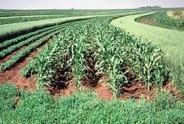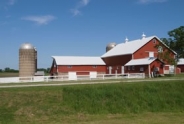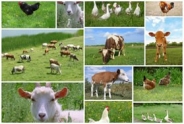A Review of the Endangered Species Act and Pesticides: An Example
Katelyn Miller, Field Crops and Forage Specialist
Southwest New York Dairy, Livestock and Field Crops Program

The Endangered Species Act (ESA) passed in 1973 requires government agencies to ensure actions taken will not threaten any species that have been federally listed as endangered or threatened. Whenever an agency has a proposed action that might affect an endangered species or its habitat, they are required to consult with one of two agencies. These agencies are the U.S Fish and Wildlife Service and U.S. National Marine Fisheries Service. These agencies, commonly referred to as the "Services" provide a biological opinion which determines if the proposed action would cause jeopardy or adverse effects to any species or habitat. If they identify a risk, the action needs to be modified to avoid harm. This is also referred to as a consultation.
The Environmental Protection Agency (EPA) oversees all pesticide use. The use of pesticides is considered an action which would require an endangered species consultation. Because the EPA has not complied with the ESA, the Federal Court has ordered them to conduct consultations on all current and newly registered pesticides. Currently, there are over 1,100 active ingredients that need to go through this review process, not including new active ingredients entering the market. To speed up the process, the EPA is developing strategies for the different groups of pesticides. Here's the current timeline:
- This past year, the EPA had an open comment period on their herbicide strategy. The final version should be available in August of 2024.
- The final version of the rodenticide strategy is planned to be released in November 2024.
- The insecticide strategy is scheduled for release in 2025. Currently, neonicotinoids are under review.
- The fungicide strategy is scheduled to be released in 2026.
- There is no schedule set for biopesticides at this time.
After these strategies are finalized, it will still take years before all pesticides have been evaluated for ESA impacts and the labels change as a result. It's important to check the label every time you purchase a product as these changes can be implemented on a label at any point. This change impacts growers where listed threatened and endangered species and agriculture overlap. There will be changes in labeling that may require additional management practices to be implemented. Some of these changes could include:
- Label requirement to check Bulletins Live! Two for additional labeling information. You can access the website here: https://www.epa.gov/endangered-species/bulletins-live-two-view-bulletins. If any additional labeling is released about a pesticide, it can be found here.
- Restrictions may be in place on application to saturated soils.
- Mitigation strategies to reduce spray drift and runoff/erosion. If products are identified as having a high risk to impact threated and endangered species, mitigation strategies may need to be implemented to use certain products using a point system. Some examples include but are not limited to removing states or counties of concern, reducing application rates, the total number of applications and field buffers.
It's important to make sure that you are always reading the label on your pesticide labels no matter how frequently you purchase a product. If you're interested, the recording of this webinar is available on YouTube on the NYSIPM channel, which can be found here: https://www.youtube.com/watch?v=WeuakbASnRU.
The following information is summarized from the webinar hosted by the Weed Science Society of America titled "Endangered Species Act and Pesticides: An Example". Every effort has been made to provide correct, complete, and up to date pesticide recommendations. Changes occur constantly and human errors are still possible. These recommendations are not a substitute for pesticide labeling. Please read the label before applying pesticides.
Upcoming Events
Crops, Cows & Critters - Southwest New York Dairy, Livestock & Field Crops Newsletter Sponsorship
December 19, 2025
Our two forms of publications feature research-based and timely information from our four specialists, listed to the right, along with local event notifications and Cornell University outreach. This information is provided to participants who range from dairy, livestock, and field crops producers to agricultural suppliers and consultants.
Weekly Email Update: Shared with 625+ households who have signed up with our program.
Monthly Paper Mailer: To reach our stakeholders and farmers who lack internet access, we send out a monthly mailer where your company's logo and contact information would be featured with a mailing list of 330+ households.
If you sponsor our weekly and monthly publications you reach approximately 955 households.
Visit our website to view our newsletters!
2025 Cornell Food Beverage & Animal Feed Manufacturer Survey
December 19, 2025
Industry and Educational Advocates for New York State's Food, Beverage, and Animal Feed Manufacturing industries:
As you know, NYS has a diverse food and beverage manufacturing industry, in both the types of industries that exist and the wide distribution of firms by scale. Many manufacturing firms have strong backward linkages to agricultural production sectors in the state that support both farm-level and downstream food industry firms and consumers. In collaboration with the New York State Department of Agriculture and Markets, a team from Cornell University's Charles H. Dyson School of Applied Economics and Management has recently rolled out the 2025 New York State Food, Beverage, and Animal Feed Manufacturer Survey. The industry will benefit from an updated assessment of the industry that informs private and public investments and opportunities to support firm growth and improved profitability.
Boots in the Barn: Cornell Dairy Research Updates
January 13, 2026
January 20, 2026
January 27, 2026
February 3, 2026
February 10, 2026
February 17, 2026
February 24, 2026
Join us for some or all!
Announcements
No announcements at this time.





